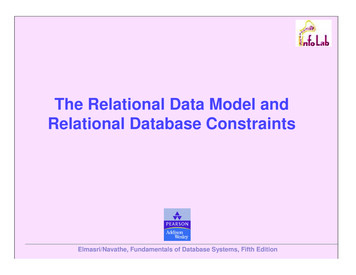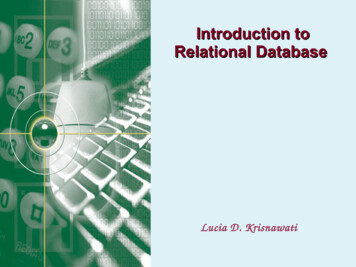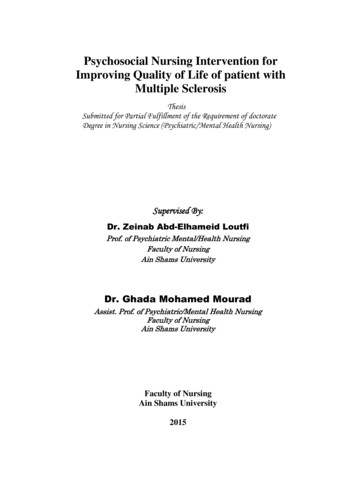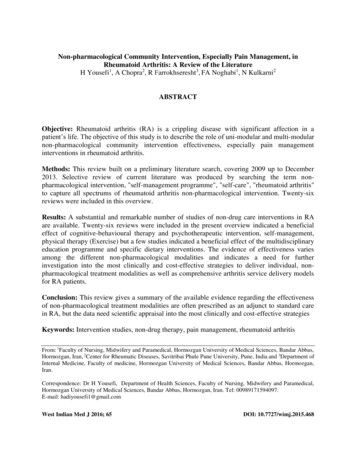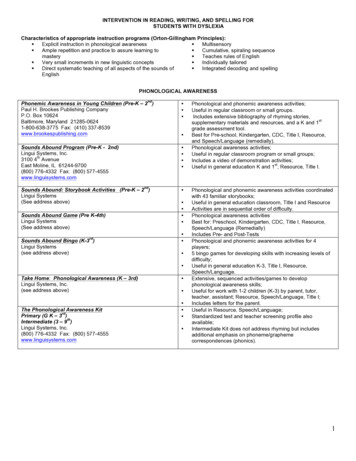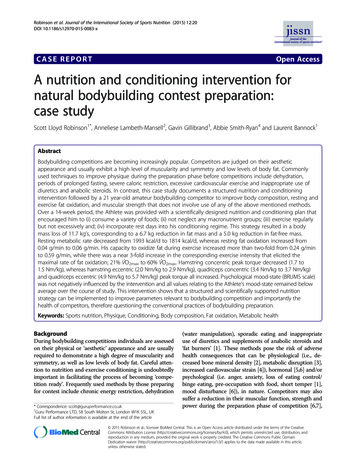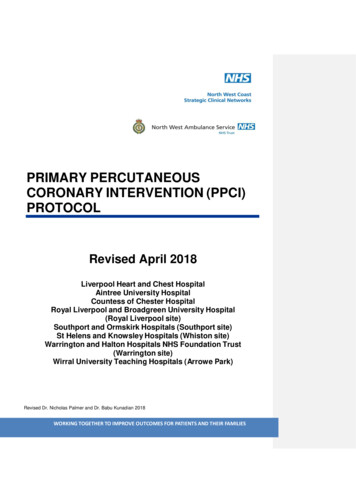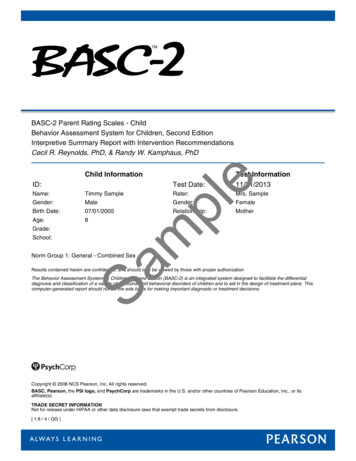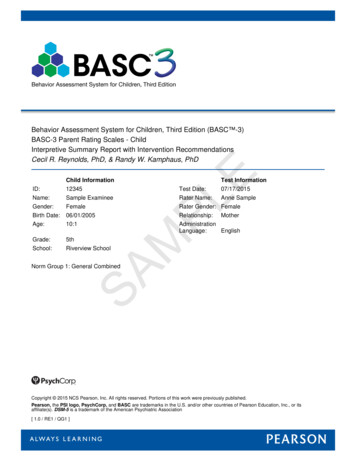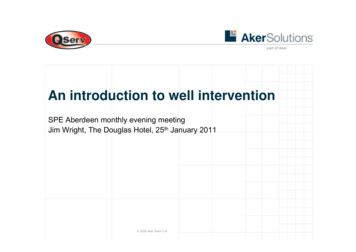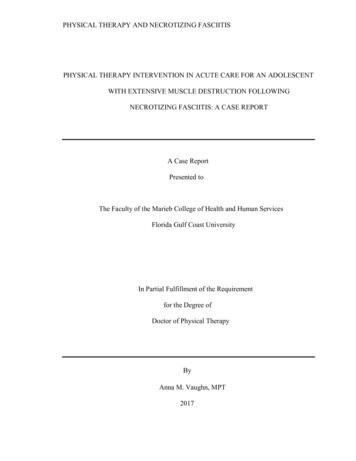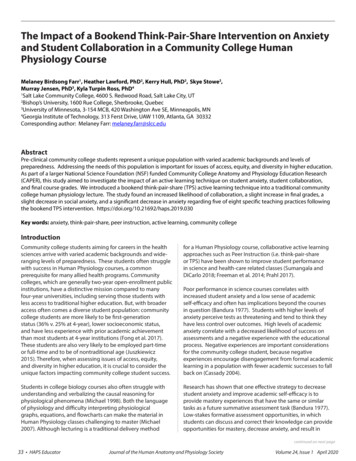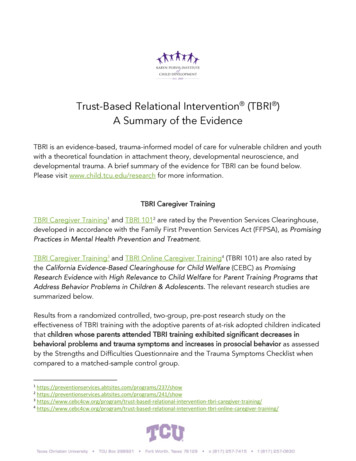
Transcription
Trust-Based Relational Intervention (TBRI )A Summary of the EvidenceTBRI is an evidence-based, trauma-informed model of care for vulnerable children and youthwith a theoretical foundation in attachment theory, developmental neuroscience, anddevelopmental trauma. A brief summary of the evidence for TBRI can be found below.Please visit www.child.tcu.edu/research for more information.TBRI Caregiver TrainingTBRI Caregiver Training1 and TBRI 1012 are rated by the Prevention Services Clearinghouse,developed in accordance with the Family First Prevention Services Act (FFPSA), as PromisingPractices in Mental Health Prevention and Treatment.TBRI Caregiver Training3 and TBRI Online Caregiver Training4 (TBRI 101) are also rated bythe California Evidence-Based Clearinghouse for Child Welfare (CEBC) as PromisingResearch Evidence with High Relevance to Child Welfare for Parent Training Programs thatAddress Behavior Problems in Children & Adolescents. The relevant research studies aresummarized below.Results from a randomized controlled, two-group, pre-post research study on theeffectiveness of TBRI training with the adoptive parents of at-risk adopted children indicatedthat children whose parents attended TBRI training exhibited significant decreases inbehavioral problems and trauma symptoms and increases in prosocial behavior as assessedby the Strengths and Difficulties Questionnaire and the Trauma Symptoms Checklist whencompared to a matched-sample control iver-training/2
Purvis, K. B., Razuri, E. B., Howard, A. R., Call, C. D., DeLuna, J. H., Hall, J. S., Cross, D. R. (2015). Decrease inbehavioral problems and trauma symptoms among at-risk adopted children following trauma-informed parenttraining intervention. Journal of Child and Adolescent Trauma, 8(3), 201-210.Results from a randomized controlled, two-group, pre-post study utilizing a self-paced, webbased version of TBRI Caregiver Training indicated that children whose parents participatedin online TBRI training exhibited significant decreases in behavioral problems and traumasymptoms assessed by the Strengths and Difficulties Questionnaire and the TraumaSymptoms Checklist, while behavioral problems and trauma symptoms of children in amatched-sample control group did not change.Razuri, E. B., Howard, A. R., Parris, S. R., Call, C. D., DeLuna, J. H., Hall, J. S., Purvis, K. B., & Cross, D. R.(2016). Decrease in behavioral problems and trauma symptoms among at- risk adopted children following webbased trauma-informed parent training intervention. Journal of Evidence-Informed Social Work, 13(2), 165-179.TBRI-Based Therapeutic CampThe first studies on TBRI came from the Hope Connection: a day camp for at-risk adoptedchildren founded by Dr. Karyn Purvis and Dr. David Cross. These studies provided earlyevidence for the intervention principles and practices that came to be known as TBRI. Keyfindings are summarized below.Results from a one-group, pre-post study of day camp indicated that at-risk adoptedchildren exhibited reduced levels of salivary cortisol, reductions in child depression, andhealthier attachment representations. Child depression was assessed with the ChildDepression Inventory and attachment representations were assessed using FamilyDrawings.Purvis, K. B., & Cross, D. R. (2006). Improvements in salivary cortisol, depression, and representations of familyrelationships in at-risk adopted children utilizing a short-term therapeutic intervention. Adoption Quarterly,10(1), 25–43.Results from a one-group, pre-post study indicated that children attending camp exhibitedsignificant improvements in externalizing and internalizing behavioral problems and inattachment-related behaviors, including decreases in thought problems, attention problems,aggressive behavior, and other problems as assessed by the Child Behavior Checklist; anincrease in positive attachment behaviors and decrease in negative attachment behaviors onthe Beechbrook Attachment Disorder Checklist; a decrease in attachment disturbance on
the Randolph Attachment Disorder Questionnaire; and an increase in positive scores anddecrease in negative scores on Family Drawings.Purvis, K. B., Cross, D. R., Federici, R., Johnson, D., & McKenzie, L. B. (2007). The Hope Connection: Atherapeutic summer day camp for adopted and at-risk children with special socio-emotional needs. Adoption &Fostering, 31(4), 38-48.See also: Purvis, K. B., McKenzie, L. B., Cross, D. R., & Razuri, E. B. (2013). A spontaneous emergence ofattachment behavior in at-risk children and a correlation with sensory deficits. Journal of Child and AdolescentPsychiatric Nursing, 26, 165-172.TBRI in Family PreservationTBRI has been taught to caregivers in a number of service settings, including adoptionpreservation. In a quasi-experimental, one-group, pre-post study, TBRI training was providedas a complementary intervention to adoptive parents participating in outpatient preservationservices. Results demonstrated significant improvements in children’s psychologicalfunctioning and parent’s stress following intervention, including improvements in children’sglobal and psychological functioning as assessed by the Brief Psychiatric Rating Scale forChildren and the Child’s Global Assessment Scale and decreases in caregivers’ stress levelsas measured by the Parental Stress Scale. Notably, findings demonstrate that caregiver andtherapist investment in the TBRI model predicted outcomes for caregivers and children,such that children whose caregivers were more invested in TBRI had a greater decrease inpsychiatric problems. Further, caregivers rated as more invested in the TBRI model had agreater decrease in stress problems.Howard, A. R., Parris, S. R., Nielsen, L E., Lusk, R., Bush, K., Purvis, K. B., & Cross, D. R. (2014). Trust-BasedRelational Intervention (TBRI ) for adopted children receiving therapy in an outpatient setting. Child Welfare,93(5), 47-64.TBRI in SchoolsIn one of the first explorations of TBRI use in schools, results describe an 18% decrease inincident reports and 23% decrease in office referrals for the top ten most frequentlyreferred students following TBRI implementation within an elementary school with an at-riskstudent population.Purvis, K. B., Milton, H. S., Harlow, J. G., Parris, S. R., & Cross, D. R. (2015). The importance of addressingcomplex trauma in schools: Implementing Trust-Based Relational Intervention in an elementary school.ENGAGE: An International Journal on Research and Practices in School Engagement, 1(2), 40-51.
Data from a charter school in a residential facility for at-risk youth suggests even greaterimprovements in incident reports for student behavior. After the first year of TBRIimplementation, school data showed a 33% decrease in referrals for physical aggression orfighting with peers. After a two-year period of TBRI implementation, school data showed a68% decrease in office referrals for physical aggression, an 88% decrease in referrals forverbal aggression, and a 95% decrease in referrals for disruptive behavior. Overall, therewere 902 such referrals in 2010-2011, but only 59 in 2012-2013, resulting in a 93.5%decrease in overall incident reports after the first two years of the implementation process.Parris, S. R., Dozier, M., Purvis, K. B., Whitney, C., Grisham, A., & Cross, D. R. (2015). Implementing Trust-BasedRelational Intervention in a charter school at a residential facility for at-risk youth. Contemporary SchoolPsychology, 19(3), 157-164.See also: Stipp, B. (2019) A big part of education also: A mixed-methods evaluation of a social and emotionallearning (SEL) course for pre-service teachers. Emotional and Behavioural Difficulties, 24(2), 204-218.TBRI in Systems of CareAs use of TBRI has expanded to new service settings, it is evident that the interventionmodel has value not only for caregiving interactions, but also for shaping systems of care forvulnerable children and youth. As TBRI is used on a larger scale, it has become necessary toevaluate and share implementation principles and practices in organizations, communities,and systems. Existing reports of implementation are summarized below, with morepublications (based on implementation projects underway or in development) anticipated inthe near future.TBRI implementation in residential treatment was first reported in the case of a 16-year-oldyouth who had a history of severe abuse and neglect before her adoption from anorphanage at age 12. The young woman, who had numerous psychiatric hospitalizationspost-adoption and had failed to respond to traditional residential treatment modalities,showed dramatic increases in pro-social and attachment behaviors and decreases in violentand self-injurious behavior following an intensive TBRI intervention. In addition, the facilitydocumented a drop in restraints and seclusions for this youth, from an average of 6.3restraints and 6 seclusions per month over the 10 months before TBRI to an average of 2.5restraints and 2.2 seclusions in the 6 months following TBRI. Although limited conclusionscan be drawn from a case study, this study provided groundwork for applying TBRI in out-ofhome caregiving systems by developing a trauma-informed milieu and involving caregiversand staff in the process.Purvis, K.B., McKenzie, L.B., Razuri, E., Cross, D.R., & Buckwalter, K. (2014). A trust-based intervention for complexdevelopmental trauma: A case study from a residential treatment center. Child & Adolescent Social Work, 31(4), 355-368.
In a case study of organizational changes in a group home providing transitional services forout-of home children and youth, improvements in behavioral incidents were documentedover the two-year period during which TBRI was implemented across the organization.These improvements included a decrease in the frequency of reported containments and ofincidents defined as “imminent risk and physical aggression” and an increase in frequency of“other incidents” such as minor client injury, disruptive behavior, and verbal aggression.These less serious staff-child interactions represent opportunities to teach self regulation in alow- risk setting and indicate that behavioral challenges were addressed before they couldescalate.Purvis, K. B., Cross, D. R., Jones, D. & Buff, G. (2012). Transforming cultures of care: A case study inorganizational change. Reclaiming Children and Youth, 21(2), 12–20.A recent exploratory study of the implementation of TBRI across several child welfareorganizations participating in a collaborative project provides an account of the complexitiesof the implementation process. Results suggests that staff across organizations showedmore favorable attitudes regarding trauma-informed care after TBRI implementation.Specifically, scale scores on the Attitudes Regarding Trauma Informed Care (ARTIC-35 HS)significantly increased in Response to Problem Behavior and Symptoms, Underlying Causeof Problem Behavior and Symptoms, and Total ARTIC Score.Crawley, R. D., Razuri, E. B., Lee, C., & Mercado, S. (2020). Lessons from the field: Implementing a Trust-BasedRelational Intervention (TBRI) pilot program in a child welfare system. Journal of Public Child Welfare.
Journal of Evidence-Informed Social Work, 13(2), 165-179. TBRI-Based Therapeutic Camp The first studies on TBRI came from the Hope Connection: a day camp for at-risk adopted children founded by Dr. Karyn Purvis and Dr. David Cross. These studies provided early evidence for the intervention pr
